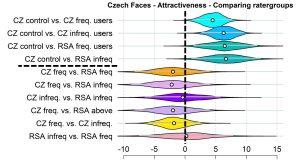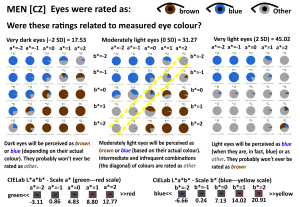Association between social media use and attribution of facial characteristics
[ENG] [PL] [ESP] ![]()
| Agreement Number | Source | Programme | Principal Investigator | Years |
| NA | YUFE Alliance, Horizon Europe MSCA |
YUFE4postdocs | Vojtěch Fiala | 2024-2026 |
The link below contains a Portable Document File that describes the project in more detail (in English only).
VojtechFiala_researchproject
Recent contributions
At PTNCE conference 2025 in Wrocław, we presented another part of the YUFE4postdocs project, under the title „Faces (on the Internet) Do Not Look All Alike: Importance of the Source of the Stimuli”.
Older contributions
At EHBEA conference in Newcastle upon Tyne, 15-17 April, 2025, the PI presented a contribution entittled “Bringing evidence of systematic differences between the faces of social media influencers and the general population”, a part of YUFE4postdocs project.
On 12th of November, 2024, I held a lecture at Kadir Has University, Istanbul, Turkey. I am thankful to my current supervisor, prof. Slawomir Wacewicz, my PhD supervisor, prof. Karel Kleisner, and our Turkish cooperator, prof. Selahattin Adil Saribay, for the option to advertise my past and current projects to local academic audience.
![]()
Details of the project
OR what we want to explore:
We are interested in influencers.
We are interested in YouTube thumbnails.
We are interested in first impressions of social media users.
We are interested in cross-cultural agreement in eye colour perception.
Digital society is a theoretical concept of an environment where evolutionary processes should work particularly fast and produce unique artefacts. When it comes to faces, we expect that:
- Influential social media users („Influencers”) possess distinctive characteristics. They may be highly attractive, trustworthy, or dominant. Alternatively, they possess unique characteristics that distinguish them from the general population.
- Are there „many ways to the top” or a „single winning strategy” for the influencers? Must every influencer be highly attractive? Or can a famous professor become an influencer due to their knowledge? Does an MMA fighter only advertise and refer to dominance? We will try to identify whether influencers recognise the specific characteristics that helped them gain popularity. We will try to describe their strategies and find a consistent association between the facial and body characteristics of the influencers, the language they and their followers use, and the strategies they take up.
- Different visual diets affect the perception, recognition, and appraisal of visual artefacts, including faces. For example, members of an ethnic minority tend to agree with the local major population of the country they live in, rather than with foreign raters of their (the same ethnicity), in perceived facial attractiveness. Potentially, high-intensity social media users present a unique group whose visual diet allows them to characterise faces of various ethnicities similarly to the local raters. Being exposed to hundreds of faces of various ethnicities on a social media feed may cause us to trace which characteristics are preferred by members of different ethnicities.
- Another project goal is to find the fine-grained structure of the association between social media use, personal characteristics, and visual perception. How shall we measure and conceptualise „Social media use intensity”? Do the different metrics correlate with each other? For example, is focusing on visual stimuli (photos and videos) important for the effect social media have on our facial perception?
- Enhanced knowledge of faces from different ethnicities may also help them recognise unique features. We are experts in recognising features that are unique to faces in our culture. Imagine a participant from a country where most of the people have brown irises. What if she spends a lot of time on social media and sees many faces with blue eyes? Would she be able to recognise this trait better?
- White eye sclera presents a conspicuous feature – a cue to humanity and human-like characteristics. Is (over)sensitivity to this characteristic related to ethnicity, environmental conditions, or social media use intensity?
![]()
First evidence
While the project started in early 2024, we can already provide some preliminary evidence on the association between facial shape, facial perception, and social media:
(1) Faces of social media creators vs. faces of the general population
Hypothesis: „There is a systematic difference between faces of the creators and faces of a random sample from the same population.” We used the methods of geometric morphometrics to describe and visualise these shape differences and check whether they are statistically significant.
We checked current social media creators („influencers”) rankings from various countries, selected local influencers from Instagram, accessed their facial photos with neutral expressions (if available) and marked them with 72 landmarks. The landmarks are anatomical or at least geometrically analogous points. We then performed generalised Procrustes analyses to assess the configuration of the faces of a given group. We compared the facial configurations of influencers with custom facial samples from the same population and performed a statistical test to see if the difference in shape was statistically significant.
For illustratory purposes, we created the average facial configurations for each sample.

Note: We also ran the same analyses on the Colombian, Czech and Turkish populations, arriving at the same result. Briefly:
> Faces of social media creators are similar to each other across cultures.
> They differ from control samples (+ creators from a selected country differ from the controls from the same country)
> Faces of controls differ from faces of controls from other countries.
> Faces of controls also seem to be less sexually dimorphic (male-female distance), compared to the creators.
Thorough report that summarises the results is to be submitted into a peer-reviewed journal in the following weeks.
Next step:
Since we cannot show the individual photos of social media creators (the project only includes facial configurations, not the faces themselves!), we cannot ask the participants as you like them. Moreover, most of the faces of social media creators use make up and take the photos under non-standard[ised] lighting conditions. However, tools of Evolutionary Psychology, including Psychomorph, allow us to manipulate facial features – if we knew the average creator and average control, we can make a random face more „creator-like” or „control-like”. Furthermore, we can show these random manipulated faces to raters (of course, without letting them know who is who). The data collection is going on in Czech Republic and is to start soon in Turkey.
![]()
(2) Evolution of thumbnails (images accompanying video titles) on YouTube
This project explores how the visual and textual elements of YouTube thumbnails influence what people choose to watch. While most research focuses on predicting video popularity using large datasets and machine-learning models, this study takes a closer look at the human side of the process.
We examine how our natural attention to various visual cues might compete or cooperate with the information we get from video titles. The project aims to understand whether certain thumbnail designs can bias viewers toward clicking on videos that are more eye-catching than relevant, and to identify broader aesthetic patterns that may have emerged through this competition between attention-grabbing visuals and informative text.
![]()
(3) Do users and non-users of online social media agree on facial characterisation (first impression formation)?
Hypothesis: „We expect social media users from different parts of the world to rate faces similarly: ratings of faces of a particular ethnicity should be more consistent among SM users than among non-users.”
Below, you can see a selected result of Bayesian analysis. Czech faces (N=195) were rated by a large Czech control sample (N = 777). Subsequently, these faces were rated by Czech Social Media Users (N = 152, half of them considered „high-intensity users”) and South African Social Media Users (N = 47, half of them assigned to the group of „high-intensity users”). Which of these groups tend to agree with the control group the most?

So far, it seems that culture (nationality) is a more important predictor of the level of agreement than the intensity of social media use. Nevertheless, it is too early to draw such conclusions because we only have two samples and the control group. Currently, data collection in other cultures is taking place (which is probably why you are here).
The crucial thing is that when we focused only on an estimate of the effect of country on the mean (ANOVA-like design) rating, we saw a completely different result:

Result report, now processed into a manuscript, is under consideration in a peer-reviewed journal (currently avaiting 2nd round of revisions).
![]()
(4) cross-cultural agreement in eye colour perception
There are cross-cultural differences in colour perception and characterisation. Iris colour variability is one of the most salient cultural differences concerning facial appearance. With certain exceptions, the population of Europe and West Asia is unique in terms of the iris [eye] colour variance. Is there a relation between iris colour variance in the population, its colour terms, and iris colour recognition ability?
Iris colour variance spanning from light blue to dark brown eyes may affect first impressions. However, three questions are yet to be adressed:
[1] Do people from different world regions agree on eye colour perception?
[2] Does it matter for first impressions based on faces?
[3] Is there an association between iris colour recognition ability and color terms in the given language and culture?
Our project also aims to characterise the cultural dependency of iris colour characterisation and map related perceptional correlates of variable iris colour.

Currently, we are analysing data from the South African sample and Czech sample and plan to run another data collection on the Indian sample (via Prolific), Colombia, Turkey, and Vietnam.
Jsem svině a zrúda a nenávidím se.

 Faculty of Humanities
Faculty of Humanities